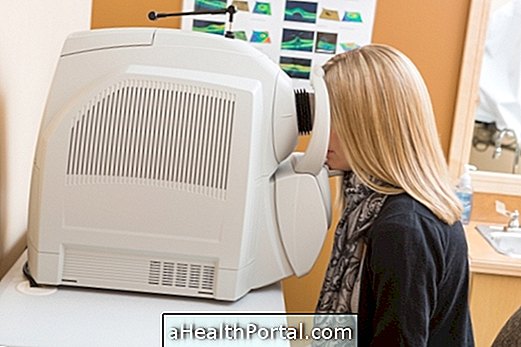Visual campimetry is done with the patient sitting and with his face glued to the meter, called a field meter, which emits points of light in different places and with different intensities in the patient's field of vision.
During the test, a light at the bottom of the device is emitted so that the patient keeps the vision focused on it. Thus, he will have to ring a bell in his hand as he can identify the new points of light that appear, but without moving his eyes to the sides, finding the lights only with the peripheral vision.

Care during the exam
Patients who wear contact lenses do not need to take them out for the exam, but they should always remember to take the last prescription for prescription glasses.
In addition, patients who are on glaucoma and use the medicine Pilocarpine should talk to the doctor and ask permission to discontinue use of the remedy 3 days before the campimetry examination.
Types of Campimetry
There are two types of examination, manual and computerized, and the main difference between them is that the manual is made from the commands of a trained professional, while the computerized test is all controlled by the electronic device.
In general, Manuel's campimetry is indicated to identify problems in peripheral vision and to evaluate patients with severe visual acuity loss, the elderly, children or debilitated persons who have difficulty following the commands of the device.
What is it for
Campimetry is an examination that evaluates vision problems and areas without visual field vision, indicating whether there is blindness in any area of the eye, even if the patient does not perceive the problem.
Thus, it is used to make the diagnosis and follow the evolution of problems such as:
- Glaucoma;
- Choroid diseases of the eye, such as choroiditis;
- Retinal diseases;
- Problems in the optic nerve, such as papilledema and papillitis;
- Neurological problems such as stroke and tumors;
- Pain in the eyes;
- Drug intoxication;
- Visual field changes;
- Migraine linked to vision problems.
In addition, this exam also looks at the size of the field of vision picked up by the patient, helping to detect peripheral vision problems, which are the sides of the field of view.
To know how to identify vision problems, see:
- How to know if I have Glaucoma
- Vista Examination
























